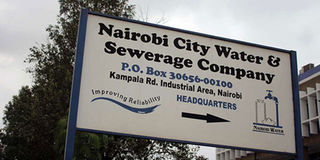Nairobi water cuts continue despite full dams

The Nairobi City Water and Sewerage Company says existing pipes can pump 525,600 cubic metres per day, which is well below the daily water demand of the city’s growing population. FILE PHOTO | NATION MEDIA GROUP
What you need to know:
- The Nairobi City Water and Sewerage Company says water rationing is here to stay despite full dams.
Nairobi residents will continue grappling with water shortages and rationing even though Ndakaini and Sasumua dams are full following heavy rains in the Aberdares. The trend has been blamed on the lower than the optimum capacity of transmission pipes.
Nairobi City Water and Sewerage Company (NCWSC) Managing Director Nahashon Muguna told the Business Daily yesterday that the existing pipes can pump 525,600 cubic metres per day, which is well below the daily water demand of the city’s growing population.
“Rationing of water is there to stay until new lines are built. The current demand is 790,000 cubic metres per day and it has been growing by nearly 20,000 cubic metres every year,” he said.
The current lines were initially set to serve the city up to the year 2000 but the government has not upgraded the infrastructure to meet the rising demand.
City residents currently face water shortages with areas such as Lang’ata, Umoja and Kawangware some of the hardest-hit.
The water crisis has pushed many residents to rely on illegal connections, kiosks and vendors.
The vendors sell a 20-litre jerrycan for as high as Sh100 amid concerns that much of the water sold is not safe for human consumption, especially in the informal settlements.
Nairobi Water and Sewerage Company started rationing water to city residents in 2017 due to rapidly plummeting water levels in Ndakaini but this has continued even after the dam filled up.
Residents in different parts of the capital city receive water on specific days of the week, some for a few days, others for just a few hours. In some estates, residents go for weeks without the precious commodity.
In July 2017, there was a cholera outbreak that led to at least three deaths with City Hall blaming it on unsafe water supplies by the vendors.
The county government is banking on the completion of the 11.8-kilometre long Northern Water Collector Tunnel to stabilise supply. The line is set for completion in December next year.
The new line will primarily collect floodwater from Maragua, Gikige and Irati rivers in Murang’a and drain into Ndakaini dam, although this will still not alleviate the problem of water shortage until the city pipeline system is upgraded.




